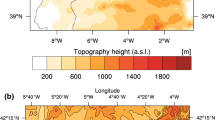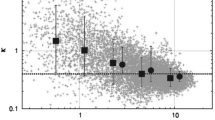Abstract
The contribution of radiative and turbulent processes to nocturnal atmospheric cooling has been studied using the experimental data of the ECLATS experiment which took place in the African Sahel; the radiative and turbulent fluxes were determined taking thermal advection into account. The turbulent cooling rate is predominant; it decreases strongly with altitude at the beginning of the night, which is the main cause of inversion formation.
Similar content being viewed by others
References
André, J. C. and Mahrt, L.: 1982, ‘The Nocturnal Surface Inversion and Influence of Clear-Air Radiational Cooling’, J. Atmos. Sci. 39, 864–878.
André, J. C., de Moor, G., Lacarrère, P., Therry, G., and du Vachat, R.: 1978, ‘Modeling the 24-hr Evolution of the Mean and Turbulent Structures of the Planetary Boundary Layer’, J. Atmos. Sci. 35, 1861–1883.
Caughey, S. J., Wyngaard, J. C., and Kaimal, J. C.: 1979, ‘Turbulence in the Evolving Stable Boundary Layer’, J. Atmos. Sci. 36, 1041–1052.
Druilhet, A. and Tinga, A.: 1982, ‘Presentation de l'expérience ECLATS’, La Météorologie VI, 29–30, 203–212.
Druilhet, A. and Durand, P.: 1984, ‘Etude de la couche limite convective sahélienne en présence de brumes sèches (expérience ECLATS)’, Boundary-Layer Meteorol. 28, 51–77.
Estournel, C., Vehil, R., Guedalia, D., Fontan, J., and Druilhet, A.: 1983, ‘Observations and Modeling of Downward Radiative Fluxes (Solar and Infrared) in Urban/Rural Areas’, J. Climate Appl. Meteorol. 22, 235–238.
Garratt, J. R., and Brost, R. A.: 1981, ‘Radiative Cooling Effects within and above the Nocturnal Boundary Layer’, J. Atmos. Sci. 38, 2730–2746.
Guedalia, D., Estournel, C., and Vehil, R.: 1984, ‘Effects of Sahel Dust Layers upon Nocturnal Cooling of the Atmosphere’, J. Climate Appl. Meteorol. 23, 644–650.
Izumi, Y.: 1971, ‘Kansas 1968 Field Program Data Report’, Environmental Research Papers, No. 379, AFCRL-72-0041, 79 pp.
Mahrt, L., Heald, R. C., Lenschow, D. H., Stankov, B., Troen, I.: 1979, ‘An Observational Study of the Nocturnal Boundary Layer’, Boundary-Layer Meteorol. 17, 247–264.
Nieuwstadt, F. T. M.: 1981, ‘The Steady-State Height and Resistance Laws of the Nocturnal Boundary Layer: Theory Compared with Cabauw Observation’, Boundary-Layer Meteorol. 20, 3–17.
Nieuwstadt, F. T. M.: 1984, ‘The Turbulent Structure of the Stable Nocturnal Boundary Layer’, J. Atmos. Sci. 41, 2202–2216.
Nieuwstadt, F. T. M. and Driedonks, A. G. M.: 1979, ‘The Nocturnal Boundary Layer: A Case Study Compared with Model Calculations’, J. Appl. Meteorol. 18, 1397–1405.
Schaller, E.: 1977, ‘Time and Height Variability of the Sensible Heat Flux in the Surface Layer’, Boundary-Layer Meteorol. 11, 329–354.
Yamada, T. and Mellor, G.: 1975, ‘A Simulation of the Wangara Atmospheric Boundary Layer Data’, J. Atmos. Sci. 32, 2309–2329.
Author information
Authors and Affiliations
Rights and permissions
About this article
Cite this article
Estournel, C., Vehil, R. & Guedalia, D. An observational study of radiative and turbulent cooling in the nocturnal boundary layer (ECLATS experiment). Boundary-Layer Meteorol 34, 55–62 (1986). https://doi.org/10.1007/BF00120908
Revised:
Issue Date:
DOI: https://doi.org/10.1007/BF00120908




